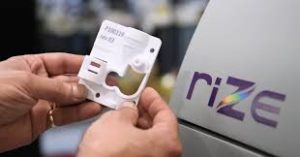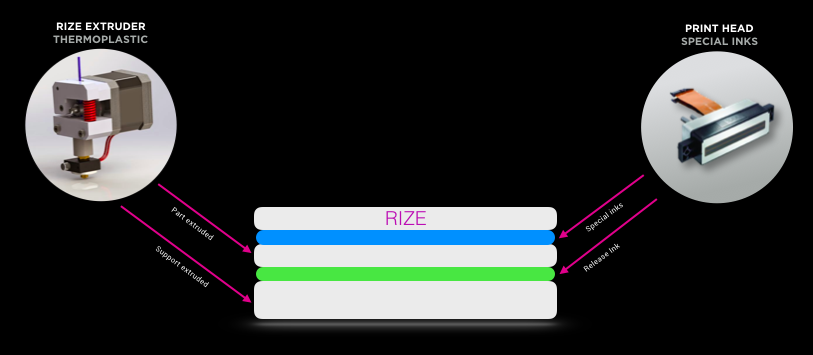 Based out of Woburn, Massachusetts, the industrial 3D printing company Rize has made it a primary goal to rid professional-grade 3D printing of the laborious and costly need for post-processing. Their recently unveiled industrial desktop 3D printer, the Rize One, is said to completely eliminate the need for post-processing, helping manufacturers cut costs and streamline their operations. Their patented Augmented Polymer Deposition (APD) enables users to bind thermoplastic filament with functional inks, which leads to simple and clean support removal.
Based out of Woburn, Massachusetts, the industrial 3D printing company Rize has made it a primary goal to rid professional-grade 3D printing of the laborious and costly need for post-processing. Their recently unveiled industrial desktop 3D printer, the Rize One, is said to completely eliminate the need for post-processing, helping manufacturers cut costs and streamline their operations. Their patented Augmented Polymer Deposition (APD) enables users to bind thermoplastic filament with functional inks, which leads to simple and clean support removal.
We recently spoke with Rize about their patented technology and removing the need for post-processing, and now, to prove the immense strain that post-processing places on manufacturers, the industrial 3D printing company has released a detailed report on the subject entitled “3D Printing: the Impact of Post Processing.” Rize commissioned renowned industry expert Todd Grimm, who has 17 years of experience in the product development industry, to construct the report. To provide a comprehensive look at the impact of post-processing, Grimm interviewed six global manufacturers representing the automotive, consumer products, medical devices, sporting goods, and architecture industries.
The report starts by discussing the misconception of post-processing as a “necessary evil,” and then moves into the two categories of post-processing: primary and secondary. Primary post-processing consists of all of the mandatory steps needed to make the part suitable for its application, which generally includes cleaning and support structure removal. Secondary post-processing, on the other hand, is used to improve the aesthetic or function of the part, which includes methods such as priming or painting.
After speaking with the six global manufacturers, Grimm was able to discern that prospective users should plan for one hour of post-processing for every one to six hours of 3D printing, which translates to a 17% to 100% increase in total process time. Of course, this time frame is completely dependent on the part itself, as smaller, more intricate parts take longer to post-process than larger, simple ones. Another factor is the staff needed for post-processing, which can range anywhere from a 1:1 to 1:3 ratio of machine operators to part finishers.
Additionally, facilities must also be considered when post-processing comes into play. The necessary post-processing equipment and workspace require a generous amount of room, usually taking up one-half to one square foot of space per each square foot of 3D printer space. As for the six companies’ biggest concerns when it comes to post-processing, time and money were among the most glaring. Grimm’s report breaks down the costs that post-processing adds to the 3D printing process – namely labor costs, which seem to be the primary concern of manufacturing companies. Those businesses operating 4 to 10 3D printers spend an average of $100,000 to $500,000 on labor, which equates to $25,000 to $50,000 per year for each 3D printer in use.
As for time, Grimm found that post-processing adds 17% to 100% additional time to the manufacturing process, which is dependent on a batch-by-batch basis. Post-processing a single part is not usually a very time-consuming endeavor, but as more parts come into play, post-processing can severely debilitate the production process. Additionally, post-processing can actually delay the process time by 24 hours or more. For instance, if a part is finished printing towards the end of the work day, the need to post-process will delay the operation until the next day.
“Without post-processing, the value of 3D printing could increase substantially,” Grimm states. “For some, it would allow them to perform more value-added tasks to improve part quality and expand the application base. For others, it would dramatically accelerate the total process, which increases responsiveness and total throughput. For those adding new 3D printers, eliminating post-processing would reduce labor expense by $25,000 to $50,000 for each machine.”
 Additionally, the six companies used in the report also cited quality, staffing, facilities, and safety as secondary issues that come with post-processing. Ultimately, Grimm claims post-processing to be a “non-value-added function” that puts a heavy burden on the manufacturing process. This is exactly why Rize and their Augmented Polymer Deposition (APD) sets them apart from other industrial 3D printer manufacturers. Their post-process-free 3D printing technology can potentially lead to a faster and more automated workflow that is more efficient and less costly.
Additionally, the six companies used in the report also cited quality, staffing, facilities, and safety as secondary issues that come with post-processing. Ultimately, Grimm claims post-processing to be a “non-value-added function” that puts a heavy burden on the manufacturing process. This is exactly why Rize and their Augmented Polymer Deposition (APD) sets them apart from other industrial 3D printer manufacturers. Their post-process-free 3D printing technology can potentially lead to a faster and more automated workflow that is more efficient and less costly.
You can read Grimm’s full report on the impact of post-processing here. Discuss further in the APD 3D Printer forum over at 3DPB.com.
Subscribe to Our Email Newsletter
Stay up-to-date on all the latest news from the 3D printing industry and receive information and offers from third party vendors.
You May Also Like
New Report: Semiconductor Industry to See $1.4B in 3D Printing Revenues by 2032
“The semiconductor sector has become the most strategically significant area of global industry.” Truer words are hard to come by when it comes to the modern world, and they are...
Will Photonic-Crystal Lasers Revolutionize 3D Printing?
Powder bed fusion (PBF) for metals and polymers predominantly utilizes lasers as the primary heat source. Some directed energy deposition (DED) technologies also employ lasers, while various vat polymerization methods...
3D Printing Unpeeled: Orbex Investment, IndoMIM and HP, Ultrasonic Waves
INDO-MIM has bought three HP Metal Jet S100 printers, operating two in India and one in Texas. This is a win for HP because the company has deep experience in...
3D Printing Webinar and Event Roundup: April 21, 2024
It’s another busy week of webinars and events, starting with Hannover Messe in Germany and continuing with Metalcasting Congress, Chinaplas, TechBlick’s Innovation Festival, and more. Stratasys continues its advanced training...

































